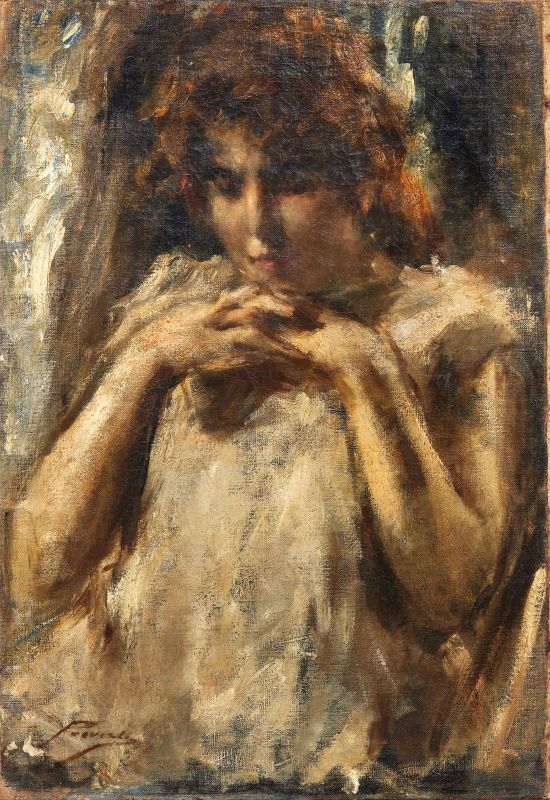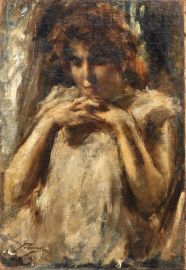Gaetano Previati (Ferrara, 1852 - Lavagna, 1920)
Gaetano Previati
Gaetano Previati
(Ferrara 1852 - Lavagna 1920)
PENSIERI
1885 circa
firmato in basso a sinistra
olio su tela
cm 81x55,5
LOST IN THOUGHT
circa 1885
signed lower left
oil on canvas
31 7/8 by 21 ¾ in
Nel periodo in cui Gaetano Previati, accanto a tematiche religiose e storiche inizia a dedicarsi a soggetti femminili dai tratti morbidi, retaggio di una pittura evanescente scapigliata che a partire dalla metà degli anni Ottanta evolve e si asciuga sempre più fino ad arrivare alla divisione del colore, nascono capolavori come Le fumatrici di hashish (1887) e la coeva Cleopatra (Concorso Canonica). Protagoniste figure femminili vestite con abiti bianchi o con camiciole leggere che lasciano nude le braccia. Nel caso di questo ritratto, collocabile intorno alla metà degli anni Ottanta, la fanciulla vista di fronte in un ambiente appena accennato sullo sfondo, ha portato le mani incrociate sotto il mento quasi volesse assumere una posizione di riposo o di meditazione. Con la testa rivolta verso l’osservatore, tiene gli occhi chiusi, raccogliendosi nei suoi pensieri. Lo sguardo di Previati è chiaramente rivolto a Tranquillo Cremona. È il colore, di intonazione uniforme, e non il disegno, che determina le forme costruite in una continuità di chiari e scuri plastici uniti da una luce soffusa e caratterizzate da una essenzialità priva di ricerche decorative. Il gesto delle mani incrociate lo si ritrova in Le Marie ai piedi della croce di fine anni Ottanta, dove la donna in primo piano, con gli occhi chiusi e il volto in questo caso verso l’alto, sembra voler riprendere il gesto di raccoglimento descritto nel nostro dipinto.
It was while he was painting religious and historical subjects that Gaetano Previati began devoting his talent to subtle female portraits – a legacy of the evanescence of the Scapigliatura Movement’s forms which began to shift in the mid-1880s, becoming dryer to develop into colour division, and masterpieces such as his 1887 works The Hashish Smokers and Cleopatra (the Canonica Competition). The subjects were females, wearing white dresses or light camisoles exposing bare arms. In this portrait, that is datable around the mid-1880s, the sitter, viewed from the front in a barely defined background, rests her head on her hands clasped under her chin as if she were resting or meditating. Her head is facing the viewer, yet her eyes are closed in thought. Previati’s “gaze” had been clearly focused on Tranquillo Cremona. It is the almost uniform colour continuously shifting from light to dark and joined by a soft, diffused light that creates the essential, unornamented shapes rather than the drawing. We see the clasped hands in The Three Marys at the Foot of the Cross, painted in the late 1880s, where the woman in the foreground with closed eyes and upturned face seems to reprise the contemplative pose of the sitter in our painting.






